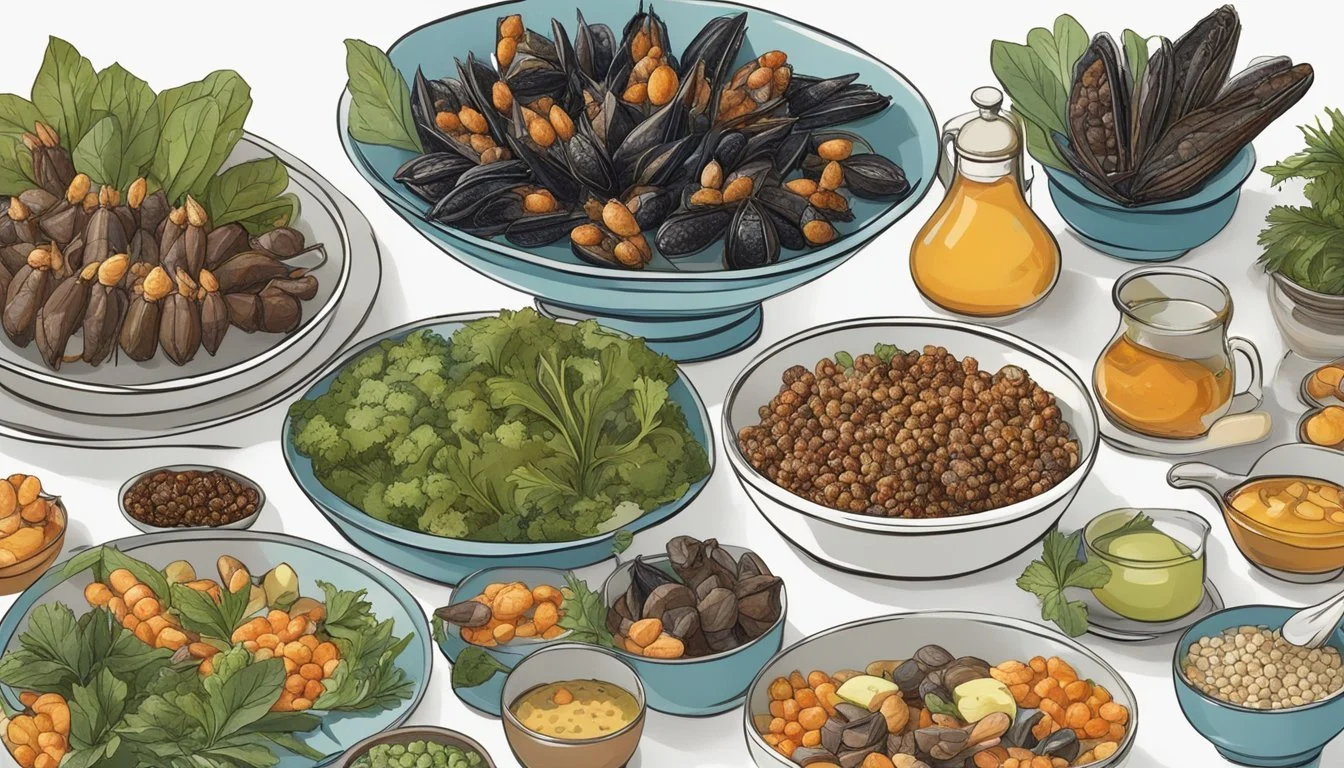Can Diabetics Eat Percebes?
Nutritional Insights and Recommendations
People with diabetes often navigate a complex dietary landscape to manage their blood sugar levels effectively. Among seafood delicacies, percebes, or goose barnacles, elicit curiosity about their suitability for diabetic diets. These crustaceans, harvested from rugged coastlines, offer unique nutritional benefits.
Percebes are low in carbohydrates, making them a potentially suitable option for those managing diabetes. Their high protein content and minimal fat can help maintain balanced blood sugar levels while providing essential nutrients. Rich in minerals and vitamins, percebes contribute to a nutrient-dense diet without the risks associated with high-sugar fruits or processed meats.
For individuals with diabetes, incorporating percebes into meals could enrich their diet with variety and essential nutrients. Careful attention to portion sizes and overall meal composition remains crucial, but the nutritional profile of percebes makes them a viable consideration.
Understanding Diabetes and Nutrition
Managing diabetes involves careful attention to diet and nutrition to maintain stable blood sugar levels. Key dietary components such as carbohydrates and fiber play crucial roles in this process.
The Role of Carbohydrates in Diabetes Management
Carbohydrates directly impact blood sugar levels. When consumed, carbs are broken down into glucose, which enters the bloodstream. Individuals with diabetes need to monitor their carbohydrate intake to prevent blood sugar spikes.
Counting carbs helps manage blood sugar levels. According to the American Diabetes Association, a low-carbohydrate diet typically involves reducing carbs to 26-45% of total calories. Sources such as non-starchy vegetables, lean proteins, and healthy fats are recommended.
Following a balanced meal plan that includes controlled portions of carbs can help reduce the risk of heart disease and maintain healthy blood sugar levels.
Nutritional Profile of Fruits
Fruits contain essential nutrients but also vary in their carbohydrate and sugar content. For instance, berries and melons offer vitamins and fiber with relatively lower glycemic index values compared to other fruits.
Those managing diabetes should stay mindful of fruits high in natural sugars, like bananas and grapes. Citrus fruits, bananas, and certain melons, while nutritious, are also high in potassium, which may need to be restricted for individuals with diabetic nephropathy.
Whole fruits are generally better than fruit juices, as they contain more fiber which helps moderate blood sugar levels.
The Importance of Whole Fruits in a Diabetic Diet
Whole fruits offer a wealth of benefits for diabetics. Dietary fiber in whole fruits slows glucose absorption, leading to gradual increases in blood sugar rather than spikes. Apps or carb-counting guides can help determine suitable portion sizes.
Fresh fruits like apples, berries, and pears are often recommended. Serving sizes are important; for example, a small piece of fruit or 1/2 cup of frozen fruit constitutes about 15 grams of carbohydrates.
Integrating whole fruits into a diabetes-friendly meal plan supports overall health, including heart health, and provides essential vitamins and minerals. Prioritizing whole fruits over processed options can aid in better diabetes management.
What Are Percebes?
Percebes, also known as goose barnacles, are highly prized crustaceans found in challenging environments like the rocky shores of Galicia, Portugal, and parts of Morocco. Their dangerous collection process significantly adds to their value and mystique in culinary circles.
Nutritional Components of Percebes
Percebes are rich in protein, making them a desirable choice for those needing a high-protein diet. They contain essential minerals like zinc and iron, which are vital for various bodily functions, including immune support and oxygen transport.
These crustaceans also offer vitamins such as B12, crucial for maintaining healthy nerves and blood cells. Despite being low in fat, they contain some saturated fat that must be considered, particularly for those monitoring their intake.
Additionally, percebes have moderate levels of sodium, which can be a concern for those with salt-sensitive conditions. They are low in cholesterol, making them a heart-friendly option in moderation.
Percebes provide a unique combination of nutrients, balancing taste and health benefits efficiently.
Safe Fruit Consumption for Diabetics
Managing diabetes effectively involves making careful food choices, especially when it comes to fruit. Understanding proper servings, preparation methods, and selecting low-glycemic fruits can help maintain stable blood sugar levels.
Recommended Fruit Servings
The right portion size is crucial for diabetics. The American Diabetes Association (ADA) suggests that one serving of fruit, which equates to about 15 grams of carbohydrate, can be obtained from 1 small piece of whole fruit or ½ cup of frozen or canned fruit. Fresh berries and melons typically allow for larger servings, ranging from ¾ to 1 cup. Opting for smaller portions helps in keeping blood sugar levels in check.
Fruit Preparation and Diabetes
Preparation methods significantly impact the fruit's effect on blood sugar. Whole fruits are preferable to fruit juices or canned fruits with added sugars, as they contain more fiber, which helps slow sugar absorption. When consuming canned fruits, selecting those packed in water or natural juice rather than syrup is better. For dried fruit, portions should be smaller given their concentrated sugar content; 2 tablespoons are a standard serving size.
Identifying Low-Glycemic Fruits
Fruits with a low glycemic index are less likely to cause rapid spikes in blood sugar. Some examples of low-GI fruits include berries, cherries, apples, and pears. These options not only provide essential vitamins and nutrients but also help in maintaining steadier blood sugar levels. Conversely, fruits like watermelon and overly ripe bananas, which are higher in sugar, should be eaten in moderation.
In conclusion, understanding and applying these principles aid diabetics in enjoying fruits while managing their condition effectively.
Potential Risks and Considerations
For diabetics, consuming Percebes requires understanding its nutritional impact and potential health risks. It's crucial to evaluate the sugar content and manage calorie intake to prevent complications related to blood sugar and other health concerns.
Sugar Content in Fruits and Diabetes
Percebes, commonly known as goose barnacles, generally contain minimal sugars compared to fruits such as bananas or oranges. Diabetics need to monitor their sugar intake to avoid spikes in blood sugar levels, which can lead to long-term complications like heart disease and stroke.
Including Percebes in the diet without adding sugar-sweetened beverages or high-sugar fruits can help manage blood sugar more effectively. Although Percebes are seafood rather than fruit, diabetics should still remain cautious of hidden sugars in any accompanying sauces or marinades.
Managing Calories and Portion Sizes
Calories play a significant role in managing diabetes, obesity, and related conditions such as high blood pressure. Percebes are low in calories and can be a low-risk option when consumed in moderation. However, portions should be controlled to maintain balanced calorie intake, helping to prevent weight gain and manage blood sugar.
Diabetics should ensure that Percebes are part of a well-rounded meal including vegetables and healthy fats. By adhering to appropriate portion sizes, they can enjoy Percebes without disrupting digestive health or contributing to conditions like heart disease. Sticking to simple preparations without high-calorie sauces ensures that the overall meal remains diabetes-friendly.
Implementing Percebes into a Diabetic Diet
Incorporating percebes into a diabetic diet involves thoughtful meal planning to ensure balanced nutrient intake and moderation in consumption. Percebes are rich in protein and other essential nutrients, making them a valuable addition to a diet aimed at managing diabetes effectively.
Incorporating Percebes into Meal Plans
To start, percebes can be included in a variety of dishes. They can be enjoyed fresh, after a simple boil in salted water for 2-3 minutes. This minimal preparation helps retain their natural flavor and nutrients.
For balance, percebes should be paired with non-starchy vegetables like leafy greens or bell peppers. These vegetables are high in fiber, which can help moderate glucose levels by slowing down carbohydrate digestion.
Balancing Percebes with Other Nutrient Sources
While percebes offer a good source of protein, it's important to balance them with other key dietary components. Combining percebes with whole grains, such as quinoa or brown rice, can provide a comprehensive meal that supports steady blood sugar levels.
In addition, mixing percebes with healthy fats from avocados or nuts can further enhance nutrient absorption and satiety. This approach ensures a varied and balanced diet, critical for effective diabetes management.
Beyond Percebes: Diverse Food Choices for Diabetics
A balanced diet for diabetics includes a variety of foods that help manage blood sugar levels. Important components of this diet are fruits, vegetables, proteins, and healthy fats.
Including a Variety of Fruits and Vegetables
Diabetics should focus on non-starchy vegetables, such as leafy greens, bell peppers, and broccoli. These vegetables are low in calories and carbohydrates, making them ideal for maintaining stable blood sugar levels.
Fruits can also be included, with an emphasis on fruits like berries. Berries, such as strawberries, blueberries, and raspberries, offer beneficial nutrients and are lower in sugar compared to other fruits.
Canned or frozen fruits and vegetables can be good alternatives if fresh options are unavailable. It's crucial to choose those without added sugar or sodium.
Including a diverse range of vegetables and fruits can ensure a supply of fiber, vitamins, and minerals while keeping blood sugar levels in check.
The Significance of Protein and Healthy Fats in Diabetic Diets
Proteins and healthy fats play important roles in a diabetic diet. Lean meats, fish, poultry, and low-fat dairy products provide necessary proteins without excessive unhealthy fats.
Nuts and seeds are excellent sources of protein and healthy fats, contributing to stable blood sugar levels and overall health. Almonds, walnuts, and chia seeds are particularly beneficial.
Healthy fat sources such as avocado and olive oil can help in maintaining good heart health, which is paramount for diabetics.
Incorporating a mix of proteins and healthy fats from various sources ensures a balanced intake of essential nutrients and supports blood sugar management.
Consulting with Healthcare Professionals
Consulting healthcare professionals is crucial for diabetics considering new dietary options like percebes. By working with a registered dietitian and keeping the diabetes care team updated, individuals can ensure their diet remains safe and beneficial.
Working with a Registered Dietitian
A registered dietitian (RD) plays a key role in helping diabetics navigate dietary changes. They can provide tailored nutritional plans that incorporate new foods like percebes while managing carbohydrate intake and maintaining blood sugar levels. The American Diabetes Association recommends involving an RD for personalized guidance.
The RD will assess how percebes fit into the overall nutritional plan, considering factors like protein, fat, and carbohydrate content. They can also provide insights into portion sizes and nutritional balance to help avoid blood sugar spikes.
In addition, an RD can offer alternatives and options that align with the individual's preferences and health goals. Regular consultations ensure that any dietary changes are sustainable and effective.
Updating Your Diabetes Care Team About Diet Changes
Keeping the diabetes care team informed about dietary changes is essential. This team typically includes doctors, endocrinologists, and Certified Diabetes Care and Education Specialists (CDCES). Informing them about incorporating percebes helps monitor the impact on blood sugar levels and adjust medications if necessary.
Regular updates enable the care team to track any positive or negative trends in health metrics. For instance, changes in HbA1c levels or daily glucose readings can prompt adjustments to the care plan.
Clear communication with the diabetes care team ensures that all aspects of the individual’s health are considered, providing a comprehensive approach to diabetes management. This proactive strategy helps in mitigating risks and achieving better health outcomes.









